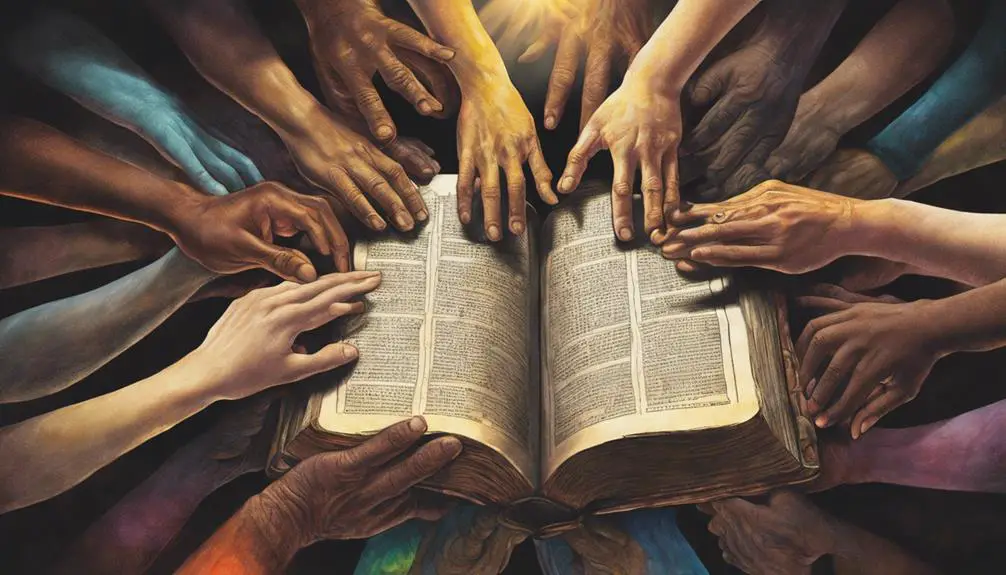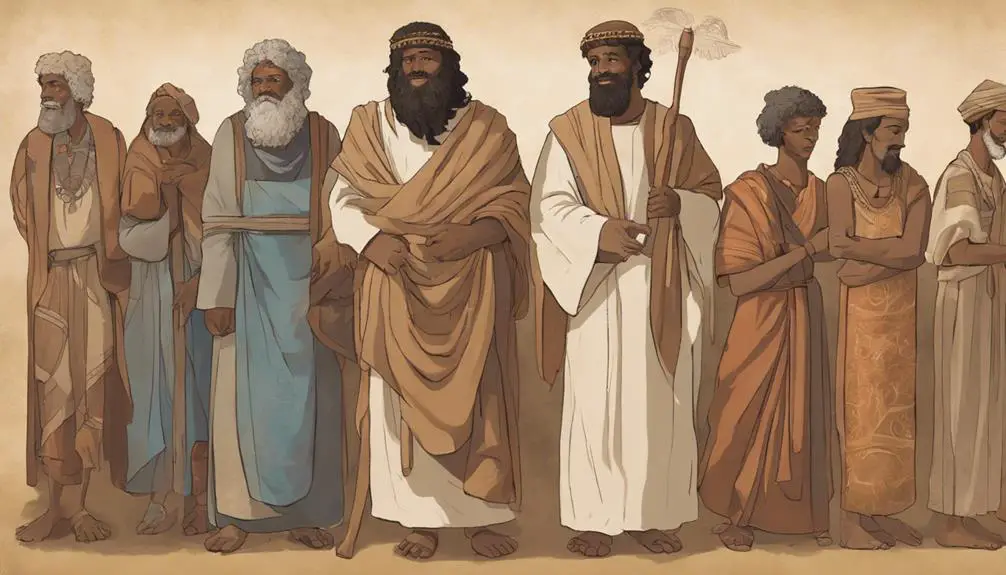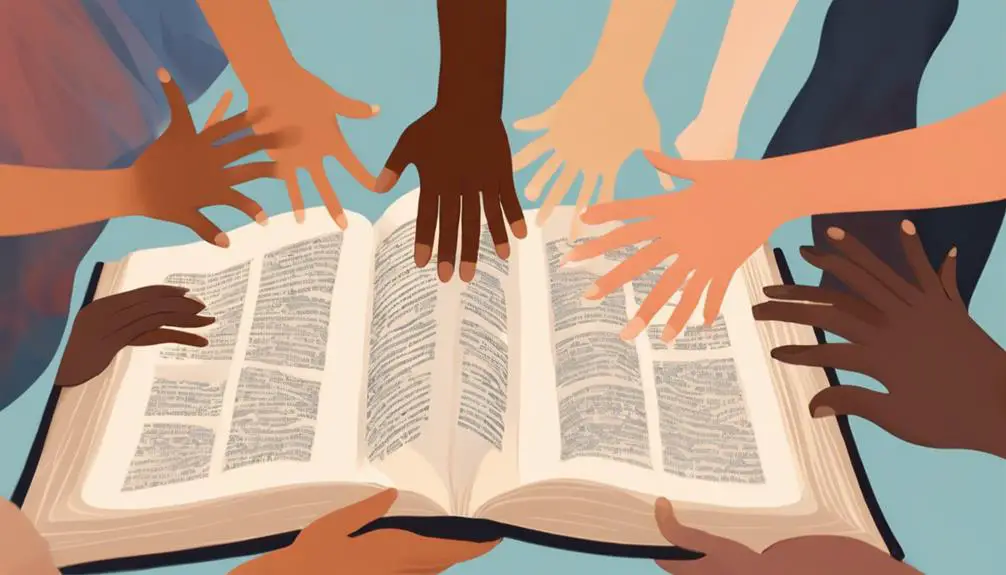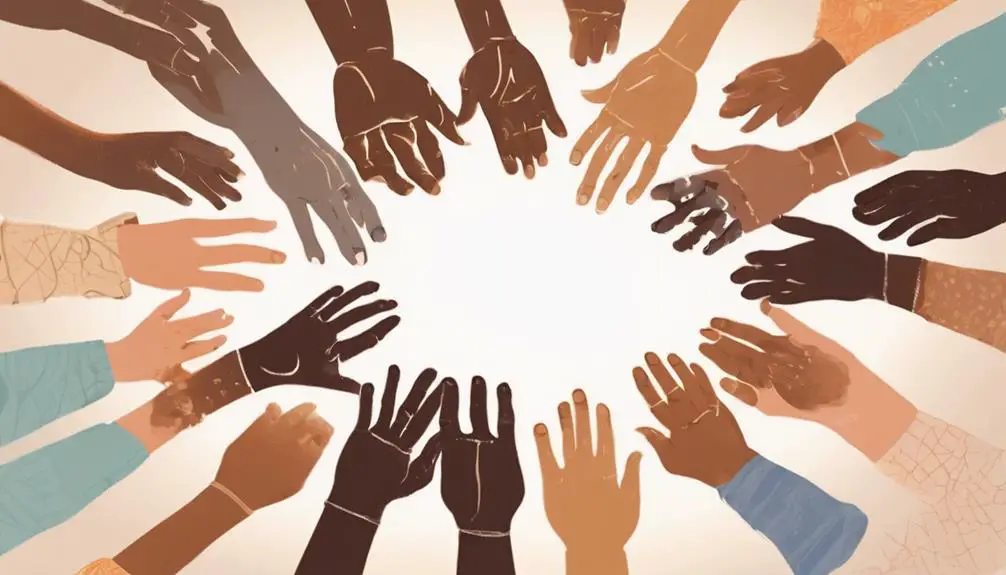Grapple with the Bible's paradoxical narratives on prejudice, inviting a deeper exploration of its historical and moral complexities.

Prejudice in the Bible
Like a mirror reflecting society's evolution, the Bible showcases both prejudice and progress within its pages. You'll find stories that seem to condone tribalism, alongside teachings that advocate for inclusivity and love beyond borders.
But here's the catch: interpreting these passages isn't always black and white. As you explore the historical context and the shifts from Old to New Testament, you'll uncover layers of meaning that might challenge your preconceptions.
This journey through scripture could offer fresh insights into overcoming bias, but only if you're willing to confront the complex interplay of culture, faith, and interpretation that awaits.
Key Takeaways
- The Bible reflects historical prejudices shaped by cultural biases and social hierarchies.
- Old Testament tribalism and New Testament inclusivity illustrate the evolution of attitudes toward prejudice.
- Misinterpretations of biblical texts can perpetuate prejudices absent context consideration.
- Biblical teachings advocate for love, understanding, and respect to overcome bias and foster unity.
Historical Context of Prejudice

Understanding the historical context of prejudice is crucial to comprehending its representation and implications in biblical texts. You'll find that cultural biases and social hierarchies deeply influenced the narratives and laws within these sacred writings. These elements weren't merely byproducts of their times; they were integral to the fabric of ancient societies that produced the Bible.
Cultural biases, for instance, colored the perceptions of different groups, often leading to depictions that mirrored the prevailing attitudes of the time. These biases weren't static; they evolved as cultures interacted, merged, or clashed. This dynamic is crucial in understanding how prejudice is woven into the narratives, shaping characters and their interactions.
Similarly, social hierarchies played a pivotal role in the construction of biblical texts. These hierarchies determined power dynamics, social roles, and the distribution of resources. They weren't just background settings but were critical in shaping the moral and ethical lessons conveyed. The acknowledgment of these hierarchies allows you to grasp the complexities of prejudice, moving beyond a surface-level reading to uncover deeper insights into the text's intentions and its reflections on human nature.
Tribalism in the Old Testament
In the Old Testament, tribalism emerges as a fundamental force shaping interactions and loyalties among different groups. This phenomenon is deeply embedded in the fabric of the society depicted, where genealogical pride and lineage play pivotal roles in defining identity and allegiance. You'll notice that the narratives often pivot around the themes of belonging and division, with tribal affiliations determining much of the interpersonal and intergroup dynamics.
The Canaanite conflicts, for instance, serve as a glaring example of how tribalism manifests in violent and contentious ways. These stories aren't just about territorial disputes; they're imbued with a sense of righteous struggle, underpinned by tribal loyalty and a profound sense of us versus them. It's in these narratives that you see a vivid illustration of how deeply entrenched tribalism could dictate the course of history, influencing decisions, and fueling conflicts.
Moreover, the emphasis on genealogical pride throughout the Old Testament isn't merely a matter of tracing lineage. It signifies a deeper, almost inherent, inclination to segregate based on ancestry and tribal affiliation. This predilection for identifying with one's tribe not only reinforces boundaries between different groups but also fosters a sense of superiority or chosenness that could exacerbate prejudices and divisions.
Inclusivity in New Testament Teachings

The New Testament introduces a paradigm shift towards inclusivity, challenging the entrenched tribalism of the Old Testament with teachings that emphasize universal love and acceptance. This evolution in thought is markedly evident in the approach taken towards Gentile inclusion. Previously, the spiritual narrative was predominantly insular, focusing on a chosen people. However, the New Testament, through the ministry of Jesus and the apostolic outreach, extends the invitation of faith beyond the Jewish community to encompass all of humanity.
Apostolic outreach, particularly through figures like Paul, embodies this commitment to inclusivity. Paul's letters frequently advocate for a community that transcends ethnic and cultural boundaries, underlining the principle that in faith, there's neither Jew nor Gentile. This radical inclusion isn't just a theological ideal but is operationalized through the establishment of diverse early Christian communities.
Furthermore, Jesus' own actions and parables, such as the Good Samaritan, serve to directly confront and dismantle the barriers of prejudice. His ministry consistently reaches out to those marginalized by society, including Samaritans, tax collectors, and sinners, thereby setting a precedent for an inclusive faith community.
Interpretations and Misinterpretations
While the New Testament's teachings promote inclusivity, interpretations and misinterpretations of these texts have often led to divergent understandings of prejudice and acceptance within Christian communities. These discrepancies can largely be attributed to two major factors: cultural bias and translation challenges. When you delve into the historical context of biblical texts, it becomes evident how cultural biases of both the past and present have shaped interpretations. Scholars and theologians bring their own perspectives and prejudices to the table, which can color the way texts are understood and taught.
Translation challenges further complicate the picture. The Bible has been translated into numerous languages over centuries, and each translation carries with it the potential for slight shifts in meaning. These shifts might seem minor, but they can significantly impact how passages are interpreted regarding prejudice and acceptance.
- *Cultural bias* influences how scripture is read and applied in different contexts, often reflecting the interpreter's own societal norms rather than the text's original intent.
- *Translation challenges* introduce ambiguities and variations, making uniform understanding difficult across different languages and cultures.
- The role of *context* is critical in interpreting biblical texts, as ignoring it can lead to misinterpretations that fuel prejudice rather than combat it.
Overcoming Bias With Biblical Insights

To effectively counteract bias, biblical insights offer valuable perspectives that challenge and refine our understanding of prejudice. By engaging with these ancient texts, you're invited to explore the complexities of human nature and the transformative power of grace and forgiveness. This journey isn't just about historical or theological knowledge; it's deeply intertwined with your spiritual growth and the cultivation of modern empathy.
The Bible, with its myriad stories of redemption, teaches you to see beyond surface-level judgments. It encourages you to recognize the inherent worth in everyone, a principle that's crucial in overcoming personal and societal biases. Through parables and teachings, it becomes evident that love and understanding are foundational to combating prejudice. These narratives push you to question your preconceptions and to embark on a path of self-reflection and improvement.
Moreover, biblical teachings emphasize the importance of community and mutual respect. They remind you that overcoming bias isn't a solitary journey but a collective effort. By fostering an environment of empathy and understanding, you contribute to a society that values diversity and unity.
In essence, the integration of biblical insights into your life doesn't just enhance your spiritual growth; it equips you with the tools to challenge and dismantle prejudice, paving the way for a more empathetic and inclusive world.
Frequently Asked Questions
How Do Modern Psychological Studies on Prejudice Compare to the Attitudes Reflected in the Bible?
Modern psychological studies on prejudice focus on concepts like implicit bias and social identity. These reveal complex underpinnings of human behavior, suggesting that biases are often unconscious and shaped by societal influences. This contrasts with the explicit moral teachings and narratives found in traditional texts.
Analyzing these studies offers insights into how social identity plays a pivotal role in shaping attitudes. It provides a nuanced perspective that goes beyond the surface-level interpretations of moral guidance.
How Have Different Cultures Around the World Interpreted or Applied Biblical Teachings on Prejudice?
As a tapestry weaves together diverse threads, cultures worldwide have embraced and adapted biblical teachings with remarkable interpretive diversity. You'll find that cultural assimilation shapes these interpretations, often reflecting a society's unique values and challenges.
This process highlights not just the universal appeal of these teachings but also the varied lenses through which they're viewed. Analyzing this phenomenon, you'll uncover a rich mosaic of understanding and application of biblical principles across different cultural landscapes.
What Role Does Translation and Language Play in Shaping Our Understanding of Prejudice in Biblical Texts?
When you delve into the role of translation and language in interpreting texts, you're engaging with how linguistic diversity and translation bias can significantly alter meanings.
The nuances lost or skewed in translation impact your understanding of complex concepts. Given the intricate process of translating texts, especially ancient ones, it's crucial to recognize how these factors shape perceptions, potentially leading to varied interpretations that reflect or distort the original message.
Are There Examples of Prejudice Within the Bible That Are Often Overlooked or Under-Discussed in Contemporary Religious Teachings?
Yes, there are often overlooked examples of prejudice, such as Canaanite exclusion and strict gender roles. These instances reveal deeper societal norms and biases of the time.
As you explore these texts, you'll find that these prejudices aren't always addressed in modern teachings, reflecting a selective interpretation of scripture.
Delving into these topics can offer a more nuanced understanding of historical contexts and the evolution of societal values over time.
How Do Various Denominations Within Christianity Today Address or Fail to Address the Historical Prejudices Found in the Bible?
You'll find that various Christian denominations tackle historical biases differently. Some actively engage in interfaith dialogue and social justice initiatives, aiming to address and rectify these prejudices.
Others, however, may sidestep the issue, not fully confronting the biases present. This discrepancy often reflects broader theological and philosophical orientations within each denomination, influencing how they interpret and act upon the historical context and teachings of their faith.
Conclusion
In sum, you've navigated through the intricate tapestry of prejudice woven into biblical narratives. From the tribalism evident in the Old Testament to the inclusivity championed in the New Testament, it's clear that interpretations and misinterpretations play a pivotal role.
As you peel back layers of historical context, remember that the devil is in the details. Overcoming bias with biblical insights isn't just about reading between the lines—it's about transforming understanding into action, academically and ethically.



Sign up